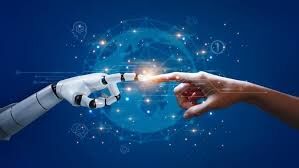Navigating 2025: Tips for Balancing AI and Human Potential

Navigating 2025: Tips for Balancing AI and Human Potential
To thrive in the AI-driven workplace of 2025, organizations need leaders who can effectively bridge the gap between technology and humanity.
As we approach 2025, the rapid evolution of AI continues to redefine the workplace. While AI promises extraordinary efficiency, creativity, and growth, it also raises critical questions about the role of human potential. The challenge for organizations lies in finding the right balance between leveraging AI-driven innovation and fostering human creativity—a task that demands thoughtful strategies and adaptive leadership.
The Case for Balance
AI’s integration into business processes has already transformed industries. From automating boring tasks to enhancing decision-making with predictive analytics, AI’s impact is undeniable. However, its rise has also led to concerns about job displacement, workplace stress, and the destruction of human connection.
“2025 will mark a critical moment for organizations as they navigate the intersection of AI-driven innovation and human potential,” said Mark Scullard, Senior Director of Product Innovation at Wiley. “Wiley’s research highlights a growing challenge—44% of people managers report severe stress levels as workloads and priorities continue to shift. To succeed, organizations must develop strategic resilience, prioritizing three key leadership skills: strategic thinking, effective communication, and change management. Technology will continue to advance, but it’s the ability to empower and engage people that will define real progress. Leaders who understand this balance will foster workplaces where AI enables growth, but human connection drives success.”
Scullard’s insights underscore the importance of aligning AI’s capabilities with the human traits that foster collaboration, creativity, and empathy. A strategic approach to this balance can ensure AI serves as a catalyst rather than a competitor.
Leadership in the Age of AI
To thrive in the AI-driven workplace of 2025, organizations need leaders who can effectively bridge the gap between technology and humanity. The three leadership skills highlighted by Scullard—strategic thinking, effective communication, and change management—are crucial in this attempt.
Strategic Thinking: Leaders must anticipate and navigate the complexities of integrating AI into existing workflows while aligning these changes with long-term organizational goals. This involves staying ahead of industry trends and ensuring AI implementation enhances rather than hinders human productivity.
Effective Communication: Clear and transparent communication is important to addressing employee concerns about AI’s impact on their roles. Leaders should promote open dialogues that build trust and encourage collaboration.
Change Management: As AI adoption accelerates, organizations will face continuous transformation. Leaders who can guide teams through these changes with empathy and adaptability will be instrumental in maintaining morale and engagement.
The Human-AI Collaboration
AI’s true potential lies in its ability to complement, not replace, human ingenuity. Prashant Sinha, Founder & CEO of BiUP.ai, adds his vision: “As we navigate 2025, the true power lies in harmonizing AI innovation with human ingenuity. AI is not a replacement but a catalyst, unlocking new realms of efficiency, creativity, and growth. The future belongs to those who embrace this balance, leveraging technology to amplify human potential while preserving the intuition and empathy that drive meaningful progress. At BiUP.ai, we believe the intersection of AI and human capability is where transformation takes shape—and the future becomes limitless.”
According to Mr. Sinha, it emphasizes the synergistic relationship between AI and humans. When used effectively, AI can automate repetitive tasks, freeing up employees to focus on strategic and creative endeavors. For example, AI-powered tools can handle data analysis, allowing teams to concentrate on interpreting insights and crafting innovative solutions.
Creating AI-Ready Workplaces
To balance AI and human potential effectively, organizations must foster an environment where both can thrive. Here are some actionable steps to achieve this:
Invest in Employee Development: Provide training programs that equip employees with the skills needed to work alongside AI. Emphasize areas such as critical thinking, problem-solving, and emotional intelligence.
Promote a Culture of Collaboration: Encourage cross-functional teams to leverage AI tools while valuing diverse perspectives. Collaborative efforts often yield more innovative outcomes.
Implement Ethical AI Practices: Ensure AI systems are transparent, unbiased, and aligned with organizational values. Ethical AI use builds trust among employees and stakeholders.
Monitor Workload and Well-being: Use AI to streamline workflows but avoid overburdening employees. Regularly assess workloads and provide support to mitigate stress.
Celebrate Human Contributions: Recognize and reward the unique contributions employees bring to the table, such as creativity, empathy, and leadership.
Looking Ahead
As AI continues to evolve, its role in the workplace will become even more prominent. Organizations that successfully balance AI and human potential will be better positioned to navigate the challenges and opportunities of 2025 and beyond.
The future workplace will not be defined solely by the sophistication of its technology but by its ability to empower people. As Scullard aptly puts it, “Leaders who understand this balance will foster workplaces where AI enables growth, but human connection drives success.” Similarly, Sinha’s vision of “the intersection of AI and human capability” highlights the limitless possibilities when these forces work in harmony.
By prioritizing strategic resilience, ethical AI practices, and human-centred leadership, organizations can create environments where both AI and people thrive. This balanced approach will not only drive innovation but also ensure that the workplace of 2025 remains a place of purpose, creativity, and connection.















